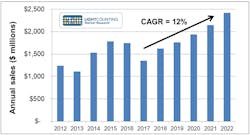Demand for FTTx, wireless optics declines from 2016: LightCounting
LightCounting says demand for optics has declined from the last year, with worldwide fiber to the x (FTTx) and wireless markets consuming approximately 100 million optical devices in 2017, worth about $1.3 billion in revenue to components makers. The market research firm points out that this 22% decline is related to a lapse in Chinese fiber to the home (FTTH) deployments in China and completion of LTE upgrades in several countries.
LightCounting says this market is expected to recover in 2018, and steadily increase over the next five years (see the figure above). To meet the government target of installing 200 million new ONU ports from 2016 and into 2018, the market research firm anticipates Chinese service providers to progress FTTH deployments in 2018. Sales of optics for 5G wireless infrastructure and 10G-PON will lead the market growth from 2019 to 2022.
In the FTTx segment, GPON currently has the largest shipment volume per year, but with considerable deployments being completed, a decline over the forecast period is likely, says LightCounting. In China,10G-PON has already succeeded GPON for current and future optical line terminal (OLT)deployments.
With the exception of Verizon and a few other operators, many countries and operators will take the same course of action, according to LightCounting (see "Verizon establishes NG-PON2 interoperability using OpenOMCI specification"). Since the cost of 10G-PON optics is far greater than GPON, component sales will increase as a result of this product fluctuation, despite the gradual decline of total volumes, LightCounting reports.
As in FTTx, the wireless market will see unit shipments decrease, while sales will benefit from a shift from 10G to the 25G (grey and WDM) optics that are necessary for 5G fronthaul. Considering their prices in comparison to slower speed, less costly devices, smaller volumes of 50G (both grey and WDM in this case as well) will contribute disproportionally to revenues.
The 2017 edition of this report includes the following new content that was not contained in the 2016 edition:
· A cable TV networks tutorial complementing the ones on FTTx and mobile fronthaul that appeared in previous editions of the report.
· Clarification on 5G network deployment timing and network requirements as the 3GPP has advanced work notablyover the past year.
· The new eCPRI standard for 5G fronthaul published in August 2017 is addressed, supported by LightCounting’s new insight into its impact on fronthaul bandwidth requirements.
· As the increased adoption of fiber deep architectures is influencing optical transceiver demand in this market segment, optics used in cable TV networks are discussed.
Changes in the forecast and forecast spreadsheet include the addition of 25G WDM and 50G WDM transceivers to the mobile fronthaul forecast, based on a growing understanding of 5G fronthaul requirements and WDM transport’s role in resolving these. A 50-Gbps category has also been added to the mobile backhaul forecast to demonstrate new information on China Mobile’s 5G transport network architecture.
The "Next-Generation Access Optics" report gives LightCounting’s insight on future optical access networks. The report includes architectures, service provider deployment strategies and trends, component requirements, and the required products. The report also includes profiles of leading vendors of access components, and analysis of historical transceiver shipment trends. An accompanying Excel spreadsheet offers a five-year forecast of fronthaul, backhaul, and FTTx optics shipments, prices, and revenues.
Sales of optical components for access networks, 2012-2022 (Source: LightCounting).
For related articles, visit the Business Topic Center.
For more information on optical modules and suppliers, visit the Lightwave Buyer's Guide.
